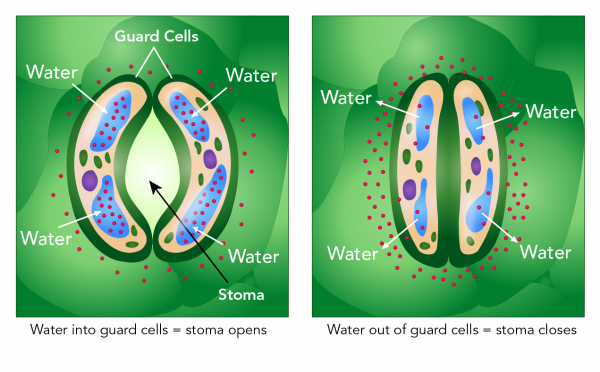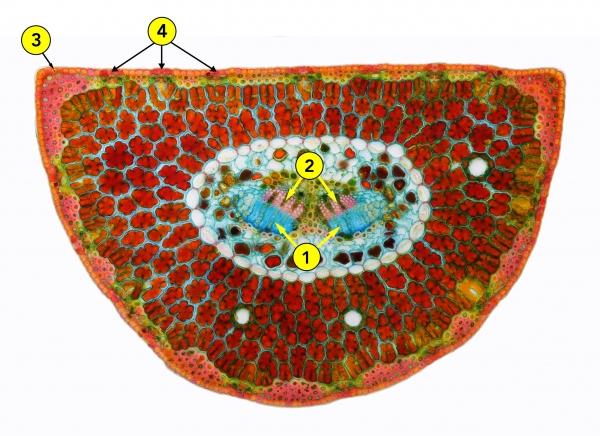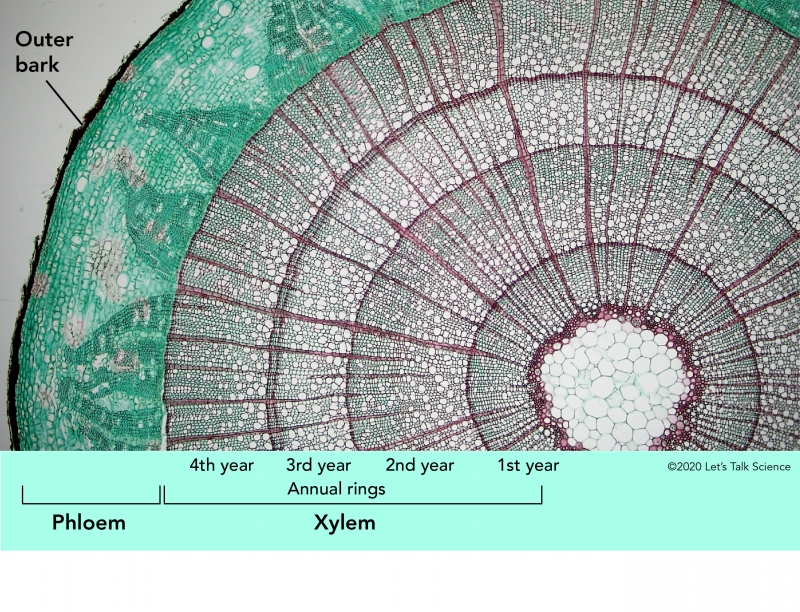How Do Trees Survive in Winter?

Coniferous and deciduous trees covered in snow (Couleur, Pixabay)

Coniferous and deciduous trees covered in snow (Couleur, Pixabay)
How does this align with my curriculum?
| Grade | Course | Topic |
|---|
What adaptations and processes do trees in northern climates have to survive winter?
When it’s cold outside, you probably put on a hat and mittens to help keep yourself warm. However, trees can’t do this. Instead, trees have a number of adaptations that allow them to survive during the winter.
First of all, there are two main types of trees found in places with cold climates, like Canada. They are known as deciduous trees and coniferous trees. Deciduous trees lose their leaves in the winter. Coniferous trees typically do not lose their leaves in winter. Their leaves, often called “needles,” stay on the trees year round. Because of this, they are often called “evergreens.” Both types of trees are adapted to survive cold temperatures. Some of these adaptations are the same and some are different.

Misconception Alert /p>
The term “Coniferous” comes from the word cones, which is what we call the reproductive parts of these plants. Some conifers lose their needles in autumn. Larch trees, whose needles turn golden yellow, are an example of this.
What adaptations do trees have for cold temperatures?
The tree’s bark acts as its first line of defence against the cold. The outer bark protects the tree from disease, insects, storms, and extreme temperatures. It is full of air spaces and works like insulation for the tree. It is similar to the insulation in the walls of your home.
Tree leaves also have adaptations for cold temperatures.
The leaves of a tree are where photosynthesis takes place. This is the process in which plants use the energy from sunlight to chemically combine carbon dioxide and water to form sugars. Trees then use these sugars for energy.
The other important process that happens in leaves is transpiration. Leaves have openings called stomata (plural of stoma). These openings are controlled by guard cells, which can open and close the stomata. During transpiration, oxygen gas and water vapour leave the tree from the stomata. As water leaves the stomata, more water is pulled up from the roots through the xylem. This is why water can flow upward in a tree!

During winter, tree roots cannot access liquid water because the ground is frozen. So, to keep the leaves from wasting water through transpiration, deciduous trees lose their leaves in autumn. The technical term for losing leaves is abscission.
But what about coniferous trees? They do not drop their needles. So how do they survive the cold, dry conditions of winter?
Coniferous trees have different leaf adaptations.
- Their needles are long and thin. This means that they have a small surface area. Less surface area means that they have fewer stomata from which to lose water. Narrow leaves also help keep snow from building up and breaking branches.
- Their stomata are not on the surface of the needle, but rather are deep within the needle. This creates a pocket of still air just inside the needle. Still air results in less transpiration than moving air.
- Their needles have thick, waxy cuticles. The cuticle is the outermost part of a leaf. The wax helps to prevent water loss. Think of how wax paper wrapped around food keeps it from drying out.

How do trees prepare for winter?
In the autumn, trees begin preparing for dormancy. They will remain in dormancy throughout the winter. During dormancy, a tree’s metabolism, or internal processes, slow down. The tree doesn’t consume as much energy, and it will stop growing. By doing this, it can conserve energy to stay alive during the cold winter.
The tree will also begin to change how it deals with water within its tissues.
Beneath a tree’s bark are the tissues that move water, sugar and other nutrients up and down the tree. It is like the tree’s plumbing system. This system contains two major types of transport tissues that act like pipelines: the phloem and the xylem. The xylem moves water and nutrients upwards from the tree’s roots to its leaves. The phloem, on the other hand, moves sugars down from the tree’s leaves to the rest of its parts. The fluids that move up and down the tree are known as sap.

A lot of water moves up and down the tree through the xylem and phloem, and if this water freezes, it can destroy the tree’s cells. This is because ice crystals are sharp and can tear through cell walls. So, just like at your home, it is important that a tree’s pipes do not have water in them that can freeze.
One way that the tree works to prevent ice damage is by controlling where ice forms. Ice has to form around something. Outdoors, this is usually things like bits of dust. In plants, ice can form around certain types of molecules called ice nucleators. Trees produce proteins that act as ice nucleators and send them in between cells.
As ice begins to form, it draws liquid water out of the tree’s cells. As more and more water is pulled out of the cells, the sap left inside the cells will contain more and more sugars. The sap becomes very thick and syrupy. It now has a freezing point lower than the environment, and so it is more difficult to freeze.
In addition to the nucleators, trees also produce antifreeze proteins. These proteins help prevent ice crystals from forming in cold temperatures.
Did you know?
Some types of trees -- such as sugar maples -- can be tapped for their sap. After enough sap is collected, it is boiled down to create the maple syrup that people love to eat on pancakes and waffles!

So now, with its water safely dealt with and its leaves taken care of, the tree is ready to settle down for a long winter’s nap. When spring comes and temperatures begin to rise once more, all of these processes will begin to reverse. This is when we see leaves starting to bud on trees and everything begins to grow again!
Starting Points
- How do you adapt to the colder temperatures of winter?
- Have you ever seen sap running from a tree in the spring? Describe what you saw.
- Do you like maple syrup? Why or why not?
- Should we support research that would look for ways to grow plants from warmer climates in colder environments such as the Arctic? Why/why not?
- Research technologies that humans have created to help protect or grow plants in unfavorable growing conditions, such as during the winter.
- What adaptations do plants have to help them survive in environments where the temperature drops below freezing? Explain.
- Are all plants able to survive winter temperatures? Why or why not?
- Do all living organisms have “survival plans”? Discuss.
- What role does photosynthesis play in a tree’s dormancy?
- This article and connecting resources, can be used to support teaching and learning of biology related to plant anatomy, plant cells, plant processes and trees. Concepts introduced include adaptations, coniferous and deciduous trees, bark, stomata, guard cells, abscission, leaf cuticle, dormany, xylem, phloem, ice nucleators and antifreeze proteins.
- This article can also be useful to help students deepen their understanding of the connections between abiotic and biotic factors in the ecosystem.
- To introduce this topic, and activate students’ prior knowledge, teachers could use an Admit Slip Learning strategy. Ready-to-use reproducibles for this article are available in [Google doc] and [PDF] formats.
- To consolidate their learning of winter adaptations by trees, students could use a Key Ideas Round Robin Learning strategy. Ready-to-use reproducibles for this article are available in [Google doc] and [PDF] formats.
- Students could design an investigation to study how temperature affects the growth and development of different types of plants.
Connecting and Relating
- How do you adapt to the colder temperatures of winter?
- Have you ever seen sap running from a tree in the spring? Describe what you saw.
- Do you like maple syrup? Why or why not?
Relating Science and Technology to Society and the Environment
- Should we support research that would look for ways to grow plants from warmer climates in colder environments such as the Arctic? Why/why not?
- Research technologies that humans have created to help protect or grow plants in unfavorable growing conditions, such as during the winter.
Exploring Concepts
- What adaptations do plants have to help them survive in environments where the temperature drops below freezing? Explain.
- Are all plants able to survive winter temperatures? Why or why not?
- Do all living organisms have “survival plans”? Discuss.
- What role does photosynthesis play in a tree’s dormancy?
Teaching Suggestions
- This article and connecting resources, can be used to support teaching and learning of biology related to plant anatomy, plant cells, plant processes and trees. Concepts introduced include adaptations, coniferous and deciduous trees, bark, stomata, guard cells, abscission, leaf cuticle, dormany, xylem, phloem, ice nucleators and antifreeze proteins.
- This article can also be useful to help students deepen their understanding of the connections between abiotic and biotic factors in the ecosystem.
- To introduce this topic, and activate students’ prior knowledge, teachers could use an Admit Slip Learning strategy. Ready-to-use reproducibles for this article are available in [Google doc] and [PDF] formats.
- To consolidate their learning of winter adaptations by trees, students could use a Key Ideas Round Robin Learning strategy. Ready-to-use reproducibles for this article are available in [Google doc] and [PDF] formats.
- Students could design an investigation to study how temperature affects the growth and development of different types of plants.
Learn more
Up Goes the Water (2004)
This article by Kathleen Damonte of the National Science Teaching Association contains information about capillary action and a simple experiment to demonstrate how it works.
A tree in wintertime (2020)
What do trees do to get through the cold season? This article form Espace pour la vie Montréal explains how they start preparing in the month of August! Learn about how and when trees begin preparing for winter.
How Do Deciduous Trees Survive Winter? (2019)
This page on brockleytree.com explains how trees prepare for winter as well as how people can help trees to survive.
References
Cocker, M. (n.d.). How do trees survive in winter? The Guardian.
Gambino, M. (2016, February 23). Survival adaptations: How trees cope with winter. Friends of Read Wildlife Sanctuary.
Gupta, R., & Deswal, R. (2014). Antifreeze proteins enable plants to survive in freezing conditions. Journal of Biosciences, 39(5), 931-934. DOI: 10.1007/s12038-014-9468-2
Lyndon Tree Care & Landscaping. (2017, January 28). How do trees survive winter?
Nix, S. (2019, April 5). Process of how trees absorb and evaporate water via roots and leaves. ThoughtCo.
North Carolina Forestry Association. (n.d.). Parts of a tree.
Perez-Watkins, M. (2019, February 1). How do trees survive the winter. National Forest Foundation.
Richford, N. (2018, December 14). Difference between deciduous and coniferous. SFGate.
Scientific American. (1997, July 15). Follow-up: How do trees carry water from the soil around their roots to the leaves at the top? Clearly, they are fighting gravity--so how do they do it?
Spears, T. (2017, January 30). Science of winter: Why trees don't freeze when it's freezing. Ottawa Citizen.